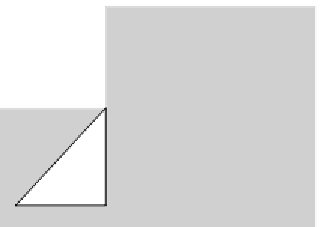Geoscience Reference
In-Depth Information
½
K
a
z
2
H/
6
z = H
/(1
;
)
and
M
max
=
(11.9)
Usually, a safety factor of
0
=2.0 is applied. For a typical soil with
=
19
kN/m
3
,
c =
0 and
=
30
o
the ratio becomes
= K
p
/K
a
=
9.0 (see equation 7.7).
Then, for a stability factor
F =
1 and a safety factor of
;
0
=2.0, equation (11.7)
yields
H/d =
0.65 and equation (11.8) yields
e/d =
0.23, and the penetration depth
becomes
D = d+e =
1.89
H
. Applying (11.9), the point of maximum bending
moment is at
z =
1.5
H
and
M
max
=
0.238
H
KNm per metre width. Finally, for a
given wall thickness and stiffness, the maximum lateral deflection at the wall top
can be determined.
In practice, one applies
e/d =
0.20, incorporating that Blum's approximation is at
the safe side. Another method is applying a safety factor on the shear strength, i.e.
tan
. The corresponding earth-pressure coefficients
K
p
and
K
a
are
adjusted, accordingly. One may include the wall friction, i.e.
mob
=
(tan
)/
?
=
mob
is taken for
the active, and
mob
for the passive zone. Then, for the resulting penetration
depth
D = d
is applied, without extension
e
.
?
=
½
a
P
A
A
deflection
H
H
d
D
d
D
(H+d)/3
(H+d)/3
d/3
d/3
P
B
P
B
B
B
e
e
(a) cantilever wall (b) anchored wall
Figure 11.7 Blum's approach
Note, that for a cantilever wall the required penetration length is significantly
more than retaining height
H
. Such wall is usually applied for supporting small
excavations. By choosing a stiff wall the lateral deflections will remain small. In
some cases a tension crack may be formed at the surface, which - when filled with
water - may have an additional serious effect on the stability.
An anchor or a prop reduces the required length of a wall, and also the lateral
deflection and bending moment. For anchored sheet-piles design the anchor force
P
A
is to be included (Fig 11.7b). Excluding the extra force
P
B
at the tip, the moment
equilibrium around the anchor point
A
yields
2
½
K
d
(
H
a
2
d
/
3
0
F =
p
(11.10)
2
½
K
(
H
d
)
(
2
H
d
)
/
3
a
)
a
For a given safety factor, the penetration depth
d
can be determined iteratively
from (11.10), and experience shows that
d
varies between 0.20
H
and 0.80
H
.
Following Blum's approach, i.e. an extension of the penetration depth with zone
e
,













































































Search WWH ::

Custom Search